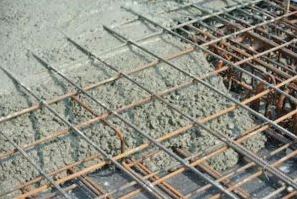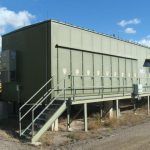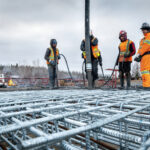Concrete construction is everywhere, however, it does come with disadvantages. These disadvantages include low strength, high weight, and high costs. In this article, we review the disadvantages of concrete as a whole, and these disadvantages as it pertains to walls, houses, and bridges.
Disadvantages of Concrete
Concrete is a brittle material and forms by mixing water, cement, and aggregate(stones) that create a bond when under enough pressure. It is one of the most popular materials used in construction and has many different applications. However, it is not always the best material to use and comes with its own set of disadvantages.

Physical Properties
Concrete possesses a relatively low tensile strength and as a result, cracks and breaks under high amounts of tension. The tiny rocks that make up concrete already have small cracks between them and when tension occurs, the cracks tend to propagate. The tensile strength of concrete averages around 300 to 700 psi and is weaker than other construction materials, such as steel which can have a tensile strength of up to 10 times that of concrete.
Compared to its strength, concrete has a very high weight, weighing around 150 pounds per cubic foot. When making concrete structures, whatever is supporting it needs to be able to bear its weight. The more concrete, the more reinforcing with steel bars and frames is needed to support the weight which adds additional weight and costs. Heavy materials can make everything more complicated as it requires more labor for transportation and installation.
Labor Costs of Concrete Construction
The additional labor costs as well as material costs make construction with concrete more expensive than alternative materials. Concrete costs are continuing to rise because of the increased demand and decreased supply of cement, costing around $8 to $13 per square foot. An increase in energy prices can also lead to a higher concrete cost due to the higher production costs in the concrete industry.

Concrete has a wide variety of uses and is an extremely common material for both residential and commercial construction. However, walls, houses, and bridges may not be the most optimal use of concrete, and here’s why.
Concrete Walls Disadvantages
When it comes to walls, concrete is not usually the first choice when choosing a material. Concrete walls are heavy, take longer to build, and are more expensive than traditional plaster or drywall walls. While concrete might be more durable, it often doesn’t make sense to use it for internal, non – load bearing walls.
It is far easier and more cost-effective to build walls out of drywall. Concrete walls are also more permanent, making it harder for renovations or additional construction. Aesthetically, many people feel being surrounded by concrete walls is primitive. As such, this factor constitutes another reason why many offices and homes utilize drywall.
Concrete Houses Disadvantages
While concrete houses may last longer than normal houses, as they are more durable to the elements, they come with many disadvantages. Brick and wood houses are far more common than concrete houses for these reasons.
- Concrete houses can cost anywhere from 10% to 60% more than wood houses.
- Concrete houses typically carry a lower aesthetic value compared to a traditonal house.
- Concrete homes also take longer to build. Once built, it’s very difficult to remodel.
Cement has been used in a unique way with its role in the 3D printing of houses. Along with a mixture of other materials, 3D cement construction prints houses, layer by layer.
Concrete Bridges Disadvantages
It is common to see bridges constructed out of concrete as they are durable in harsh environments and require little maintenance. Concrete bridges often require support beams, making them less adequate for long spans when compared to steel bridges. Steel also tends to last longer than concrete bridges, meaning lower maintenance costs.

While concrete possesses a low tensile strength, it’s high compressive strength makes it optimal for arch bridges and as a support for most types of bridges. Steel bridges often take less time to build as they are lighter and require less labor. This is a huge benefit not just for the people, but for the environment as well. Shorter construction time means less time that the environment encounters machines, waste, and pollution.
Bridges aren’t typically constructed out of just one material. Different materials provide better suitability for different parts of the bridge. Steel joints and beams provide rigidity while concrete provides the deck construction material. Of course, internal steel rebar supports provides structural rigidity for concrete as a standard part of concrete construction.
A bridge constructed entirely out of concrete and steel rebar supports would take longer to complete than a steel-hybrid version. It would also lack the ability to span long distances and require significant structure support.



